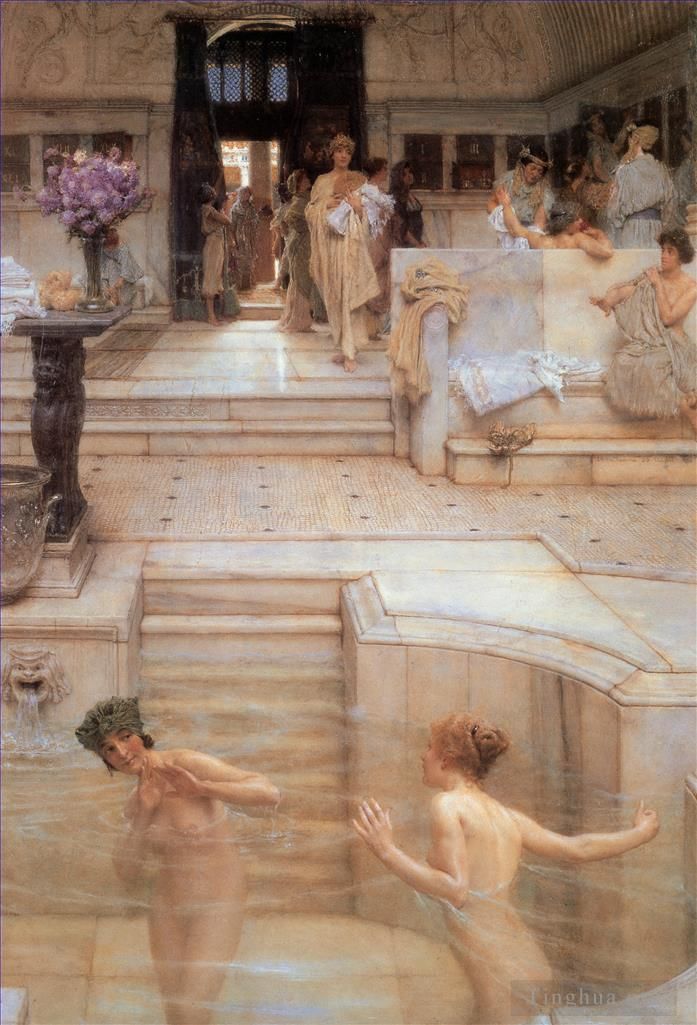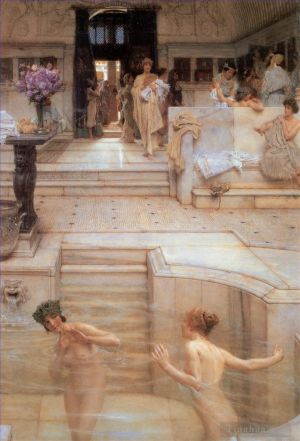A Favourite Custom
Sir Lawrence Alma-Tadema
- Price: Price on Request
- Art Type: Oil Painting
- Size:
- English Comments: 0
- International Comments: 0
- Creating Date:
- Introduction and Works of Sir Lawrence Alma-Tadema >>
Work Overview
- A Favourite Custom
Sir Lawrence Alma-Tadema
Date: 1909
Style: Romanticism
Genre: genre painting
Media: Oil on wood
Dimensions: 45 x 66.1 cm
Location: Tate Modern, London, UK
It is a surprise to find Sir Lawrence Alma-Tadema hanging next to Walter Sickert because he looks like a painter from a different era. His idealised classical nudes made a success of the traditional style and were bought straight away for the nation. A Favourite Custom showed the coldest of the Roman baths, the frigidarium, in accurate archaeological detail, flattering the classical learning of educated Victorians. They are, however, more modern than they look. Hygiene was a newly important social and health concern in cities like London. The beautifully painted surfaces – wet skin, silken hair, diaphanous fabrics, flowers, silver, glass, mosaic and marble – are intensely physical. These luxurious materials appealed to a consumerist bourgeoisie. The greys, mauves and whites suit the cold setting and enhance the eroticism of the warm pink bodies. Alma-Tadema is often accused of painting ‘Victorians in togas,’ but he saw it the opposite way, ‘the old Romans were human flesh and blood like ourselves, moved by the same passions and emotions’.
This scene is set in the baths at Pompeii. In the foreground one woman playfully splashes another bathing in the ‘frigidarium’, a cold bath. The artist based this work on photographs of the ruins of the Stabian baths, revealed by archaeologists in 1824. He has made them more luxurious by adding a marble floor and walls which would more usually have been found in larger imperial baths. This small work attracted enormous success when it was exhibited and bought immediately for the nation.
This scene is set in the Stabian baths at Pompeii. In the foreground one woman playfully splashes another bathing in the 'frigidarium', a cold bath. Others gather in an undressing room beyond. The artist based this work on photographs of the remains of the baths, revealed by archaeologists in 1824. He has made them more luxurious by adding a marble floor and walls which would more usually have been found in larger imperial baths. The Dutch-born artist Alma-Tadema achieved enormous success in Britain with carefully researched scenes like this of daily life in the ancient Roman world.
- Copyright Statement:
All the reproduction of any forms about this work unauthorized by Singing Palette including images, texts and so on will be deemed to be violating the Copyright Laws.
To cite this webpage, please link back here.
- >> English Comments
- >> Chinese Comments
- >> French Comments
- >> German Comments
- >>Report
- Death of the Pharaohs Firstborn Son
- A Pyrrhic Dance
- Summer Offering Young Girl with Roses
- Between Venus and Bacchus
- A Roman Emperor AD41detail1
- Portrait of Ignacy Jan Paderewski
- Portrait Of Mrs Charles Wyllie
- The Massacre of the Monks of Tamond
- Pandora
- Who is it
- Egyptian juggler
- A Family Group
- The Death of Hippolytus
- A reading from homer detail
- A world of their own
- The Crossing of the River Berizina 1812
- A Hearty Welcome
- In the Temple Opus 1871
- The Flower Market
- A Roman Art Lover2
- The Sculptors Model
- Ask me no more
- In My Studio
- Expectations
- Welcome footsteps
- A Bath An Antique Custom
- A Declaration
- Portrait of a Woman
- Autumn Vintage Festival
- Ave Caesar Io Saturnalia
- Spring Flowers
- Unwelcome Confidences
- The Picture Gallery
- A Roman Emperor
- Boating
- Caracalla and Geta
- The voice of spring
- The Finding of Moses 1904
- Shy
- A votive offering
- A Harvest Festival A Dancing Bacchante at Harvest Time
- Thou Rose of all the Roses
- Portrait of Aime Jules Dalou his Wife and Daughter
- Flora Spring in the Gardens of the Villa Borghese
- The Sculpture Gallery detail
- A Collection of Pictures at the Time of Augustus
- Prose
- A Difference of Opinion
- A Silent Greeting
- Caracalla
- The Potter
- Poetry
- Confidences
- Maria Magdalena
- Golden hour
- Phidias Showing the Frieze of the Parthenon
- A Listner
- Exhausted Maenides after the Dance
- Interrupted
- The Vintage Festival
- Master John Parsons Millet
- A greek woman
- Proclaiming Claudius Emperor
- Flag Of Truce
- Between Hope and Fear
- The Drawing Room at Townshend House
- Venantius Fortunatus Reading His Poems to Radegonda VI
- Portrait Of Miss Laura Theresa Epps
- Strigils and sponges
- Always Welcome
- Drawing Room Holland Park
- Self Portrait
- Pastimes in Ancient Egyupe 300Years Ago
- The Coliseum
- The Roses of Heliogabalus
- Miss Alice Lewis
- Sunshine
- The years at the spring
- Agrippina with the ashes of Germanicus Opus XXXVII
- Interior of Caius Martiuss House
- A reading from homer
- Joseph Overseer of the Pharoahs Granaries
- Tibullus at Delias
- God Speed
- Midday Slumbers
- The Roman Wine Tasters
- Hadrian Visiting a Romano British Pottery
- A Roman Art Lover
- British 18361912A Roman Scribe Writing Dispatches
- On the Road to the Temple of Ceres
- In the Peristyle2
- Faust and Marguerite
- The Baths of Caracalla
- The parting kiss
- Sappho and Alcaeus
- Interior of the Church of San Clemente Rome
- Sculptors in Ancient Rome
- Egyptian Chess Players
- Sir Lawrence From An Absent One
- A Dedication to Bacchus
- Preparation in the Colosseum detail
- Vain Courtship
- Preparation in the Colosseum
- Mrs George Lewis and Her Daughter Elizabeth
- Dolce Far Niente
- Loves Jewelled Fetter
- A Picture Gallery
- When Flowers Return
- Courtship
- A Favourite Custom
- Maurice Sens
- The Favourite Poet
- Tarquinius Superbus
- Unconscious Rivals
- The Sculpture Gallery
- Architecture in Ancient Rome
- Hopeful
- Portrait of the Singer George Henschel
- After the audience
- Cherries
- Sir Lawrence The Soldier Of Marathon
- Hero 1898
- The Triumph of Titus
- A Prize For The Artists Corps
- Antony and Cleopatra
- Ninetyfour in the Shade
- The Education of the Children of Clovis
- The Frigidarium
- Resting
- Silver Favourites
- Entrance to a roman theatre
- Gallo Roman Women
- An exedra
- Sir Lawrence An Audience
- Loves Votaries
- Not at home
- The Siesta
- A sculpture gallery
- A Street Altar
- Pottery painting
- The Discourse
- Courtship the Proposal
- Lawrence Bacchanale 1871
- Under the Roof of Blue Ionian Weather
- Xanthe and Phaon
- Leaving Church in the Fifteenth Century
- Summer Offering
- Water Pets
- A Birth Chamber
- Portrait of Anna Alma Tadema
- In the Tepidarium
- Pleading
- The Soldier of Marathon
- This is our Corner Laurense and Anna Alma Tadema
- Whispering Noon
- Catullus at Lesbias
- The Way to the Temple
- The Honeymoon
- The Conversion Of Paula By Saint Jerome
- An earthly paradise
- Preparations for the Festivities
- Promise of spring
- Comparisons
- An Oleander
- A kiss
- The Family Group
- My Studio
- The Epps Family Screen
- In the Time of Constantine
- Lesbia Weeping over a Sparrow









 Singing Palette
Singing Palette